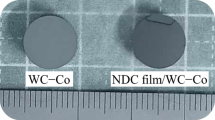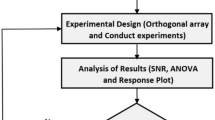Abstract
Due to the random and unpredictable shortcomings of traditional polishing, we have carried out research on the fixed abrasive polishing in anhydrous environment. In the fixed abrasive polishing, the particle size is one of the main reasons that affect the quality of the processing. The purpose of this paper is to grasp the deterministic polishing technology, and experiments were conducted to explore the effect of particle size on the workpiece roughness and sub-surface damage (SSD). The results show that there is a nonlinear relationship between roughness and particle size, which may be the result of mechanical and chemical effects in the polishing process. Also, due to the mechanical removal, the SSD still exists and origins with the larger particles in the tail of particle size distribution. Through the experiment and research, we can get the best processing conditions that ceria wheel with a particle size of 100 nm can polish the fused silica with a roughness of 1.98 nm, and the SSD depth is only 80 nm.


















Similar content being viewed by others
Data availability
The data that support the findings of this study are available from the corresponding authors upon reasonable request.
References
Suratwala TI, Feit MD, Steele WA (2010) Toward deterministic material removal and surface figure during fused silica pad polishing [J]. J Am Ceram Soc 93(5):1326–1340. https://doi.org/10.1111/j.1551-2916.2010.03607.x
Li Y (2015) Recent progress in bound-abrasive polishing of fused silica glass [C]. Optifab 2015. Int Soc Optic Photon 9633:963327. https://doi.org/10.1117/12.2197485
Ottman J C, Shen J C S (1983) Fixed abrasive polishing method and apparatus: U.S. patent 4,393,628 [P]. 1983-7-19.
Der Velden PV (1999) Chemical mechanical polishing with fixed abrasives using different subpads to optimize wafer uniformity [J]. Microelectron Eng 50(1):41–46. https://doi.org/10.1016/S0167-9317(99)00262-2
Kim HY, Kim H, Jeong H, Seo H, Lee S (2003) Self-conditioning of encapsulated abrasive pad in chemical mechanical polishing [J]. J Mater Process Technol 142(3):614–618. https://doi.org/10.1016/S0924-0136(03)00641-1
Choi JY, Jeong HD (2004) A study on polishing of molds using hydrophilic fixed abrasive pad [J]. Int J Mach Tool Manu 44(11):1163–1169. https://doi.org/10.1016/j.ijmachtools.2004.04.006
Lin B, Jiang XM, Cao ZC, Huang T, Li KL (2020) Theoretical and experimental analysis of material removal and surface generation in novel fixed abrasive lapping of optical surface. J Mater Process Technol 279:116570. https://doi.org/10.1016/j.jmatprotec.2019.116570
Gillman BE, Jacobs SD (1998) Bound-abrasive polishers for optical glass [J]. Appl Opt 37(16):3498–3505. https://doi.org/10.1364/AO.37.003498
Bouzid D, Belkhie N, Aliouane T (2012) Optical glass surfaces polishing by cerium oxide particles [J]. Iop Conf 28:012007. https://doi.org/10.1088/1757-899X/28/1/012007
Zhou L, Shimizu J, Eda H, Kimura S (2005) Research on chemo-mechanical-grinding (CMG) of Si wafer [J]. J Japan Soc Precis Eng. supplement.contributed Papers 71(4):466–470. https://doi.org/10.2493/jspe.71.466
Zhou L, Shiina T, Qiu Z, Shimizu J, Yamamoto T, Tashiro T (2009) Research on chemo-mechanical grinding of large size quartz glass substrate [J]. Precis Eng J Int Societ Precis Eng Nanotechnol 33(4):499–504. https://doi.org/10.1016/j.precisioneng.2009.01.006
Li Y, Wu Y, Zhou L, Fujimoto M, Wang J, Xu Q, Sasaki S, Kemmochi M (2012) Chemo-mechanical manufacturing of fused silica by combining ultrasonic vibration with fixed-abrasive pellets [J]. Int J Precis Eng Manuf 13(12):2163–2172. https://doi.org/10.1007/s12541-012-0287-9
Li Y, Wu Y, Zhou L, Fujimoto M (2014) Vibration-assisted dry polishing of fused silica using a fixed-abrasive polisher [J]. Int J Mach Tool Manu 77:93–102. https://doi.org/10.1016/j.ijmachtools.2013.10.005
Tang H, Yang W, Liu W, Ma J, Luo X (2020) Characteristic of fixed abrasive polishing for fused silica in anhydrous environment [J]. Optik 202:163623. https://doi.org/10.1016/j.ijleo.2019.163623
Zhang Z, Liu W, Song Z (2010) Particle size and surfactant effects on chemical mechanical polishing of glass using silica-based slurry [J]. Appl Opt 49(28):5480–5485. https://doi.org/10.1364/AO.49.005480
Zhou C, Shan L, Ng SH, Hight R, Paszkowski AJ, Danyluk S (2001) Effects of nano-scale colloidal abrasive particle size on SiO2 by chemical mechanical polishing [J]. MRS Proc 671:M1.6. https://doi.org/10.1557/PROC-671-M1.6
Hecker RL, Liang SY, Wu XJ, Xia P, Jin DGW (2007) Grinding force and power modeling based on chip thickness analysis [J]. Int J Adv Manuf Technol 33(5-6):449–459. https://doi.org/10.1007/s00170-006-0473-y
Hecker RL, Liang SY (2003) Predictive modeling of surface roughness in grinding [J]. Int J Mach Tool Manu 43(8):755–761. https://doi.org/10.1016/S0890-6955(03)00055-5
Cook LM (1990) Chemical processes in glass polishing [J]. J Non-Cryst Solids 120(1-3):152–171. https://doi.org/10.1016/0022-3093(90)90200-6
Suratwala TI, Feit MD, Steele WA, Wong L, Shen N, Dylla-Spears R, Desjardin R, Mason D, Geraghty P, Miller P, Baxamusa S (2014) Microscopic removal function and the relationship between slurry particle size distribution and workpiece roughness during pad polishing [J]. J Am Ceram Soc 97(1):81–91. https://doi.org/10.1111/jace.12631
Liu WJ, Yang W, Guo YB (2019) Characteristic of bound-abrasive polishing for fused silica glass in anhydrous environment [C]. In: 9th International Symposium on Advanced Optical Manufacturing and Testing Technologies: Advanced Optical Manufacturing Technologies, vol 10838. International Society for Optics and Photonics, p 1083808. https://doi.org/10.1117/12.2504799
Chen PH, Huang BW, Shih HC (2005) A chemical kinetics model to explain the abrasive size effect on chemical mechanical polishing [J]. Thin Solid Films 476(1):130–136. https://doi.org/10.1016/j.tsf.2004.09.049
Randi JA, Lambropoulos JC, Jacobs SD (2005) Subsurface damage in some single crystalline optical materials [J]. Appl Opt 44(12):2241–2249. https://doi.org/10.1364/AO.44.002241
Suratwala TI, Wong L, Miller PE, Feit MD, Menapace J, Steele R, Davis P, Walmer D (2006) Sub-surface mechanical damage distributions during grinding of fused silica [J]. J Non-Cryst Solids 352(52):5601–5617. https://doi.org/10.1016/j.jnoncrysol.2006.09.012
Koshy P, Jain VK, Lal GK (1993) A model for the topography of diamond grinding wheels [J]. Wear 169(2):237–242. https://doi.org/10.1016/0043-1648(93)90304-5
Suratwala T, Steele R, Feit MD, Wong L, Davis P (2008) Effect of rogue particles on the sub-surface damage of fused silica during grinding/polishing [J]. J Non-Cryst Solids 354(18):2023–2037. https://doi.org/10.1016/j.jnoncrysol.2007.11.015
Suratwala T, Wong L, Miller P, Feit MD, Menapace J, Steele R, Davis P, Walmer D (2006) Sub-surface mechanical damage distributions during grinding of fused silica [J]. J Non-Cryst Solids 352(52-54):5601–5617. https://doi.org/10.1016/j.jnoncrysol.2006.09.012
Ahn Y, Cho NG, Lee SH, Lee D (2003) Lateral crack in abrasive wear of brittle materials [J]. JSME Int J 46(2):140–144. https://doi.org/10.1299/jsmea.46.140
Funding
This work was supported by the National Natural Science Foundation of China (No. 52075462).
Author information
Authors and Affiliations
Contributions
Xinyu Luo and Wei Yang constructed the theoretical model. Wei Yang designed the experiment. Measurements were performed by Xinyu Luo and Yuan Qian. Xinyu Luo, Wei Yang, and Yuan Qian analyzed the data and contributed to writing the manuscript.
Corresponding author
Ethics declarations
Ethical approval
Not applicable.
Consent to participate
Not applicable.
Consent to publish
Not applicable.
Competing interests
The authors declare no competing interests.
Additional information
Publisher’s note
Springer Nature remains neutral with regard to jurisdictional claims in published maps and institutional affiliations.
Rights and permissions
About this article
Cite this article
Luo, X., Yang, W. & Qian, Y. Fixed abrasive polishing: the effect of particle size on the workpiece roughness and sub-surface damage. Int J Adv Manuf Technol 115, 3021–3035 (2021). https://doi.org/10.1007/s00170-021-07363-1
Received:
Accepted:
Published:
Issue Date:
DOI: https://doi.org/10.1007/s00170-021-07363-1




